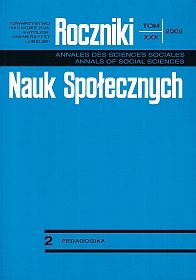Szkoły i drukarnie zakonne na ziemiach dawnej Rzeczypospolitej w XVIII-XIX wieku
Abstrakt
In the beginning the author shows the historical process through which the concept of collegium took shape as a university residence for students and professors, a boarding house for students (not only in Poland but also in such countries as France, Italy, England, Spain, and Germany), a secondary school and a semi-high school (occupational or other) before going to university. The further parts of the paper is devoted to collegia as secondary schools.
Starting from the 16th century on, collegia (secondary schools) were established in Poland. They were run by religious orders which can be defined as teaching orders. They were as follows: Jesuits, Piarists, Theatins, and Basilians. In the period of the Enlightenment, ie in the second half of the 18th century, other orders joined them. In order to satisfy the social need, they organized and ran secondary schools, e.g. Benedictines, Cistercians, Friars of the Tomb of the Lord, Regular Lateran Canons, Bartolomites, (also called communists for they strictly abode by the life in a religious community). The religious collegia comprised the teaching staff with its rector at the head, a number of didactic rooms, a church, and the religious home (with different names), the boarding house called a convict, a library, and a theatrical hall. In bigger centres there wad a printing house, a pharmacy with a hospital, research-didactic studies, an astronomical observatory, (botanic and fruit) gardens, workshops for production and service, and other buildings. The author gives the number of those collegia, discusses their structure and curricula in particular periods from the 16th to the 18th century. Similarly, he has characterized noble convicts, being part of the collegium and occupied with elite education for the future politicians and state officials. Their students came from nobel and magnate families.
Now diocesan seminars were important didactic-educational institutions (in the 17th-18th centuries they provided a two-year and in the 19th century a four-year tuition. They were run by the Congregation of Missionaries of St Vincent a Paulo (Congregatio Sacerdotum Saecularium Missionis S.V. a Paulo).
Finally, the author quotes a number of printing houses at the above collegia and seminar in Poland in the years 1700-1864 and points to the main types of their publishing production, such as: various kinds of handbooks, ABC books, catechisms, didactic manuals, calendars, posters and theatrical plays, sermons, prayer books, liturgical, historical, theological, and fiction works. He postulates further reach on the collegia and religious printing houses.
Copyright (c) 2002 Roczniki Nauk Społecznych

Utwór dostępny jest na licencji Creative Commons Uznanie autorstwa – Użycie niekomercyjne – Bez utworów zależnych 4.0 Międzynarodowe.


